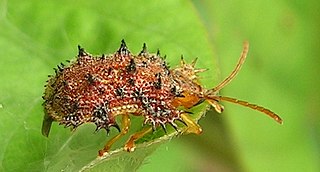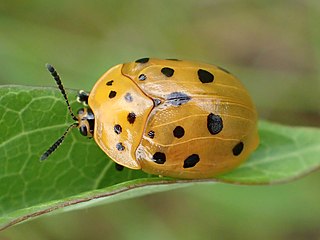
Cryptocephalus is a genus of leaf beetles in the subfamily Cryptocephalinae and belonging to the group of case-bearing leaf beetles called the Camptosomata.

The Cassidinae are a subfamily of the leaf beetles, or Chrysomelidae. The antennae arise close to each other and some members have the pronotal and elytral edges extended to the side and covering the legs so as to give them the common name of tortoise beetles. Some members, such as in the tribe Hispini, are notable for the spiny outgrowths to the pronotum and elytra.

Galeruca tanaceti is a species of leaf beetle found in the Palearctic realm, and is the type species of the genus Galeruca. It feeds on various plants in both its adult and larval stages. The species was first described by Carl Linnaeus in his 1758 10th edition of Systema Naturae.

Cryptocephalus biguttatus is a species of cylindrical leaf beetle belonging to the family Chrysomelidae, subfamily Cryptocephalinae.

Cryptocephalus sericeus is a species of beetle of the family Chrysomelidae, subfamily Cryptocephalinae.

Bromius obscurus, the western grape rootworm, is a species of beetle in the leaf beetle family. It is the only member of the genus Bromius. The distribution of the species is holarctic; it can be found in North America, wide parts of Europe, and Asia. The species is a known pest of grape vines in Europe and western North America.

Cryptocephalus trimaculatus is a species of cylindrical leaf beetle belonging to the family Chrysomelidae, subfamily Cryptocephalinae.

Cryptocephalus virens is a cylindrical leaf beetle belonging to the family Chrysomelidae, subfamily Cryptocephalinae. The species was first described by Christian Wilhelm Ludwig Eduard Suffrian in 1847.

Cryptocephalus marginatus is a cylindrical leaf beetle belonging to the family Chrysomelidae, subfamily Cryptocephalinae. The species was first described by Johan Christian Fabricius in 1781.

Cassida viridis, common name green tortoise beetle, is a species of beetle in the leaf beetle family (Chrysomelidae).

Aspidimorpha sanctaecrucis, sometimes called the golden tortoise beetle, is an Old World species of beetle belonging to the family Chrysomelidae.

Chiridopsis punctata is a species of leaf beetles belonging to the family Chrysomelidae.

Alurnus ornatus is a species of beetle in the family Chrysomelidae that can grow 19–27 millimeters in length. It is found in Colombia, Costa Rica, Nicaragua, and Panamá.

Cryptocephalus flavipes is a beetle belonging to the family Cryptocephalus.
Cryptocephalus downiei, or Downie's spotted leaf beetle, is a species of case-bearing leaf beetle in the family Chrysomelidae. It is found in North America. The specific epithet downiei honors American psychologist and coleopterist Norville Downie.
Chaetocnema denticulata, the toothed flea beetle, is a species of flea beetle in the family Chrysomelidae. It is found in North America.

Chelymorpha cassidea, known generally as the Argus tortoise beetle or milkweed tortoise beetle, is a species of leaf beetle in the family Chrysomelidae. It is found in the Caribbean and North America.

Hemisphaerota cyanea, known generally as palmetto tortoise beetle, is a species of leaf beetle in the family Chrysomelidae. Other names include the Florida tortoise beetle and iridescent blue chrysomelid beetle. It is native to the southeastern United States, from North Carolina, south to Florida, and west to Mississippi. It is introduced to southern Texas.

Podontia affinis is a species of flea beetle in the family Chrysomelidae. It is native to Indo-China, Indonesia, India, Malaysia and Yunnan.

Cryptocephalus moraei is a species of beetle from the genus Cryptocephalus. The species was originally described by Carl Linnaeus in 1758.


















